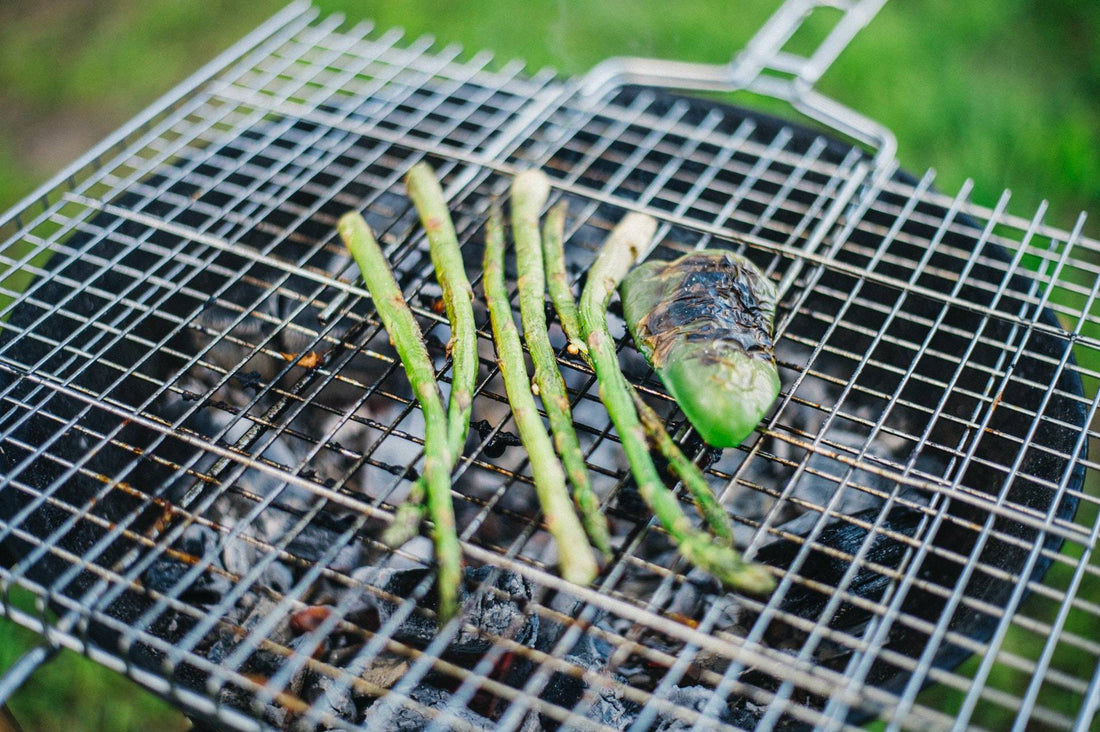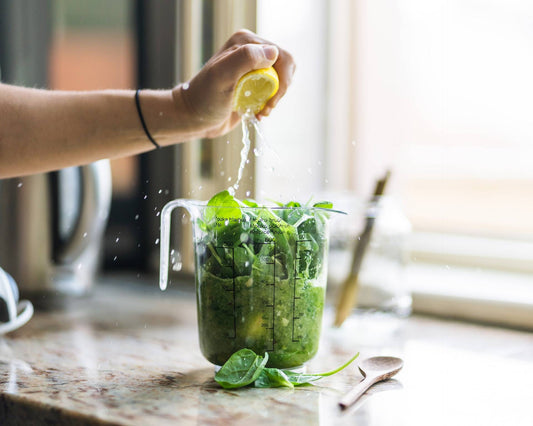

As we step into the full swing of summer, you may find yourself enjoying the sunshine with family and friends around the grill!
De-stressing with loved ones, getting your vitamin D, time in nature ... all great things for your microbiome health. But one thing that’s not very gut-friendly? The typical American cookout menu.
It’s usually packed with inflammatory foods like sugar and processed items, artificial flavors and preservatives, and low-quality meat. All of which can harm your gut, and lead to chronic health issues if consumed often.
So today, just in time to plan your summer gatherings, we’ve rounded up five delicious and flavorful gut-friendly recipes to bring to your next barbecue:
The Drink: Watermelon Juice (from Eating Well)
Simple and refreshing, nothing says summer like watermelon! If you want to jazz up this drink and add a powerful probiotic, try adding a splash of kombucha.
Ingredients
-
1 (6 pound) seedless watermelon
-
¼ cup lime juice
Directions
Cut watermelon in half. Using a large spoon, scoop out and reserve the pink flesh (you will have about 8 cups). Discard rind. Process the watermelon and lime juice in a blender (in batches if necessary) until smooth and frothy, about 30 seconds. Pour the mixture through a fine-mesh strainer into a pitcher, pressing with a spoon to release juices. Discard solids. Pour the juice into 4 ice-filled glasses.
The Salad: Massaged Kale Salad (from Nutrition Stripped)
Made with kale as the base, which is full of fiber and vitamin A, this salad can be customized based on your preferences! Try the classic made with omega-3 rich walnuts, a zesty vegan Caesar, or the Cobb for a boost of protein.
Ingredients
- 2-3 cups Massaged Kale Salad recipe below
- 3 tablespoons hemp seeds
- 1/2 avocado
- 2 tablespoons nutritional yeast
- 1/2 cup chickpeas
- garlic, optional
Directions
Prepare massaged kale salad and set aside in a serving bowl. In a blender or food processor, combine avocado, hemp seeds, nutritional yeast, and optional garlic and a dash of apple cider vinegar. Blend together for a thick and creamy dressing. Pour over kale and combine, then top with chickpeas. If you’d like to add another protein source instead of a vegetarian-friendly protein, try grilled chicken. Enjoy!
The Side Dish: Homemade Sauerkraut (from Minimalist Baker)
This tangy, crunchy sauerkraut is not only filled with gut-friendly probiotics and easy to make, but it’s also versatile. You can add it to a sandwich or wrap, toss it in a salad, or simply enjoy on it’s own!
Ingredients
- 8 cups red or green cabbage (finely grated or chopped)
- 1 ½ – 2 tsp sea salt (plus more to taste)
- 1 small beet (finely shredded)
- 3 whole carrots (finely shredded)
- 3 Tbsp fresh ginger (shredded / grated)
- 3 Tbsp fresh turmeric (shredded / grated)
- 4 cloves garlic (finely minced)
The longer it sits and ferments, the tangier it will become, so sample occasionally with a clean utensil to test and see if it is at the right stage for you. Once it has reached the desired tanginess, cover securely and transfer to the fridge, where it should keep at least 3 months and up to 6 months. When serving, don’t double dip to avoid contamination.
The Main Dish: Grilled Honey Glazed Salmon (from Dr. Axe)
Instead of the standard burger or hot dog, grilled salmon can be a great gut-healthy swap to try. Made with garlic and ginger, this recipe brings the flavor and fights inflammation.
Ingredients
¼ cup honey
4 minced garlic cloves
1 teaspoon grated ginger
1 tablespoon melted ghee
¼ cup coconut aminos
1 tablespoon chopped fresh thyme
Sea salt and black pepper, to taste
2 pounds wild caught Alaskan salmon
Directions
In a small pan, whisk together honey, garlic, ginger, ghee, coconut aminos, thyme, salt and pepper. Place salmon into pan and coat with mixture. Refrigerate for 15 minutes, flip salmon in pan and recoat other side. Refrigerate for another 15 minutes. Preheat an outdoor grill for medium heat and lightly oil grate. Remove salmon from marinade, shake off excess, and discard remaining marinade. Grill until internal temperature reaches 145 F, or until the fish flakes easily with a fork. Serve hot immediately.
The Dessert: Strawberry Lemon Kefir Pie (from Cultured Food Life)
Made with probiotic-rich kefir and without any refined sugar, you’d be hard-pressed to find a better gut-friendly summer dessert than this strawberry lemon kefir pie. Bonus: no need to use the oven on a hot summer day!
Ingredients
-
Crust
- 1 cup Sprouted Graham Crackers – (You can use regular graham crackers too)
- 1/4 cup butter – melted
Filling
- 1 tablespoon unflavored gelatin – or 2 packs unflavored gelatin
- 3/4 cup milk
- 1 cup Kefir
- 8 ounces cream cheese
- 1 small lemon – zest and juice
- 1-2 cups strawberries – chopped
- 1/2 cup honey – or Stevia
Directions
Crust:
Place all ingredients for crust in a food processor. Process for 1 minute or until blended well. Press into pie pan.Enjoy your Summer BBQ!
Gut-friendly meals don’t have to be boring or bland, in fact, far from it.You can take great care of your health, while enjoying plenty of summer cookouts.
And if you do find yourself eating foods you don’t usually eat or more sugar than usual, don’t forget to take your Sugar Shift to head-off inflammation and restore your digestive health!
With gratitude,

 Martha Carlin, is a “Citizen Scientist”,
systems thinker, wife of Parkinson’s warrior, John Carlin, and founder of The BioCollective , a microbiome company expanding
the reach of science and BiotiQuest, the first of it’s kind probiotic line. Since John’s diagnosis in 2002,
Martha began learning the science of agriculture, nutrition, environment, infectious disease, Parkinson’s
pathology and much more. In 2014, when the first research was published showing a connection between the gut
bacteria and the two phenotypes of Parkinson’s, Martha quit her former career as a business turnaround expert
and founded The BioCollective to accelerate the discovery of the impact of gut health on all human disease. Martha was a speaker at the White House 2016 Microbiome Initiative launch, challenging the scientific
community to “think in a broader context”. Her systems thinking background and experience has led to collaborations
across the scientific spectrum from neuroscience to engineering to infectious disease. She is a respected out of the
box problem solver in the microbiome field and brings a unique perspective to helping others understand the
connections from the soil to the food to our guts and our brains.
Martha Carlin, is a “Citizen Scientist”,
systems thinker, wife of Parkinson’s warrior, John Carlin, and founder of The BioCollective , a microbiome company expanding
the reach of science and BiotiQuest, the first of it’s kind probiotic line. Since John’s diagnosis in 2002,
Martha began learning the science of agriculture, nutrition, environment, infectious disease, Parkinson’s
pathology and much more. In 2014, when the first research was published showing a connection between the gut
bacteria and the two phenotypes of Parkinson’s, Martha quit her former career as a business turnaround expert
and founded The BioCollective to accelerate the discovery of the impact of gut health on all human disease. Martha was a speaker at the White House 2016 Microbiome Initiative launch, challenging the scientific
community to “think in a broader context”. Her systems thinking background and experience has led to collaborations
across the scientific spectrum from neuroscience to engineering to infectious disease. She is a respected out of the
box problem solver in the microbiome field and brings a unique perspective to helping others understand the
connections from the soil to the food to our guts and our brains.


Waking Up to a Probiotic Breakfast Can Do Wonders for Your Gut Health
Did you know that recent studies show people with poor gut diversity had lower quality of life? The health of your microbiome impacts your mental health, sleep, energy, the risk for chronic illnesses, and much more. A probiotic breakfast can...

Can Probiotic Supplements Make or Break Your Fast?
Intermittent fasting (IF) may have started as a fitness trend for weight loss, but today it's a go-to lifestyle choice for many. Practicing intermittent fasting has been linked with health benefits such as lowering blood sugar and insulin, preventing heart...














 Martha Carlin
Martha Carlin







